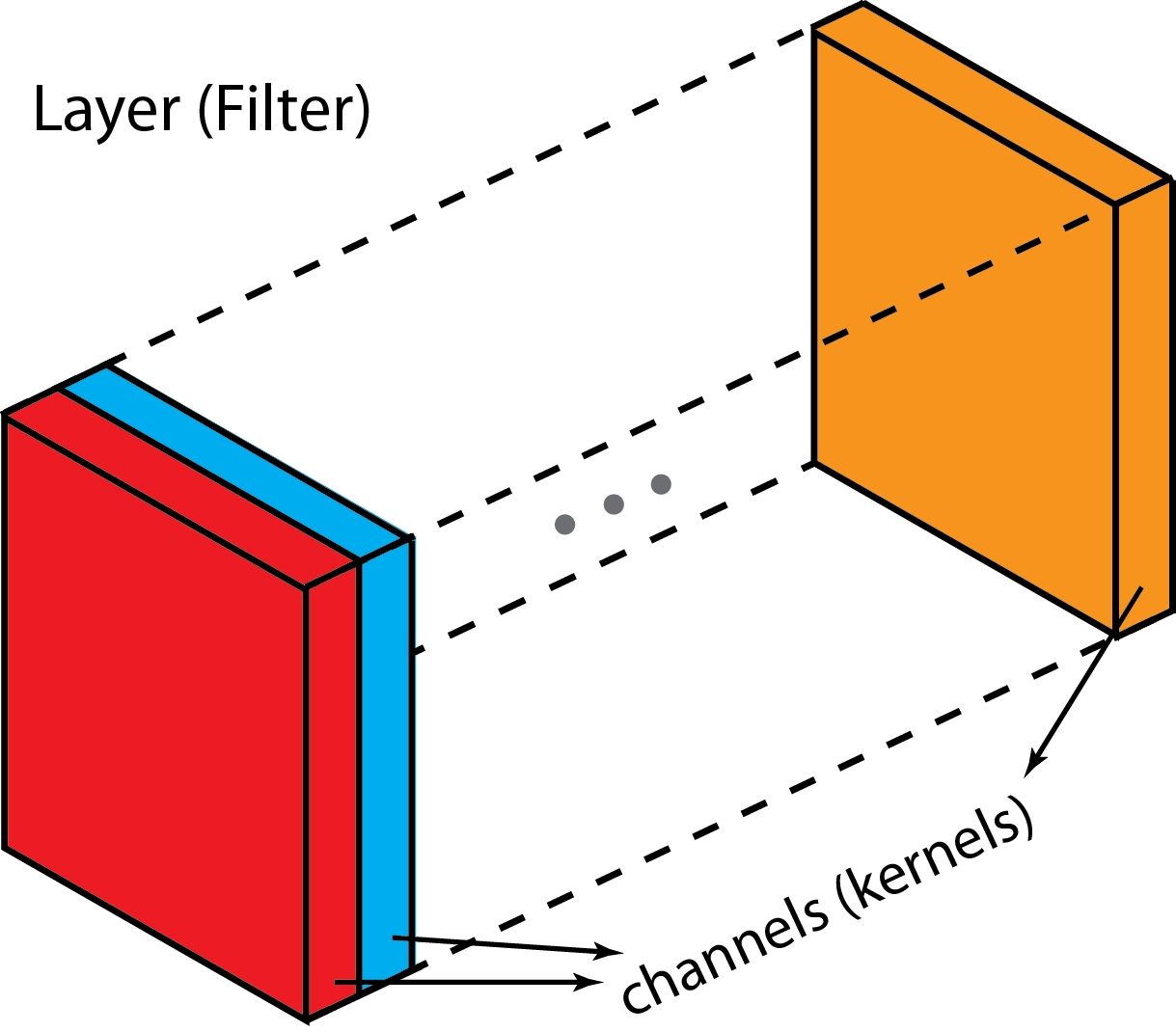Convolution
There are different types of Convolution in CNN such as
2D Conv, 3D Conv
1x1 Conv, BottleNeck
Spatially Separable
Depthwise Separable
Grouped Convolution
Shuffled Grouped
Read the following blog for more detailed explanations on types of convolution
Convolution: single channel
It is the element-wise multiplication and addition with window sliding.
Read the followings for more detailed information


Using 3x3 kernel. from 5x5=25 input features --> 3x3=9 output.
Common techniques in convolution
Padding: pad the edges with '0','1' or other values
With padding: WxHxC --> WxHxC
Without padding: WxHxC -> (W-w+1)x(H-h+1)xC
image from here

Striding: skip some of the slide locations
⌊(nh−kh+ph+sh)/sh⌋×⌊(nw−kw+pw+sw)/sw⌋.
With padding: WxHxC (W+S-1)/S x (H+S-1)/S x C Without padding: WxHxC (W-w+S)/S x (H-h+S)/S xC


Filter vs Kernel
For 2D convolution, kernel and filter are the same
For 3D convolution, a filter is the collection of the stacked kernels

2D Convolution: multiple channel
The filter has the same depth (channel) as the input matrix.
The output is 2D matrix.
Example: Input is 5x5x3 matrix. Filter is 3x3x3 matrix.

Then, three channels are summed by element-wise addition to form one single channel (3x3x1)



3D Convolution
A general form of convolution but the filter kernel size < channel size. The filter moves in three directions: height, width, channel
The output is 3D matrix.

1D Convolution
Input: HxWxD. Filtering with 1x1xD produces the Output' HxWx1

Initially, proposed in 'Network-in-Network (2013)' . Widely used after introduced in 'Inception (2014)'
Dimensionality reduction for efficient computations
HxWxD --> HxWx1
Efficient low dimensional embedding, or feature pooling
*
Applying nonlinearity again after convolution
after 1x1 conv, non-linear activation(ReLU etc) can be added
Cost of Convolution
Calculation cost for a convolution depends on:
Input size: i*i*D
Kernel Size: k*k*D
Stride: s
Padding: p
The output image ( o*o*1 ) then becomes

The required operations are
o*o repetition of { (k*k) multiplications and (k*k-1) additions}
In terms of multiplications
For input of size H x W x D, 2D convolution (stride=1, padding=0) with Nc kernels of size h x h x D, where h is even
Total multiplications: Nc x h x h x D x (H-h+1) x (W-h+1)
Separable Convolution
Used in MobileNet(2017), Xception(2016) for efficient processing.
Spatially Separable Convolution
Not used much in deep learning. It is decomposing a convolution into two separate operations
Example: A Sobel kernel can be divided into a 3 x 1 and a 1 x 3 kernel.


Depthwise Separable Convolution
Commonly used in Deep Learning such as MobileNet and Xception. It is two steps of (1) Depthwise convolution (2) 1x1 convolution
For example: Input 7*7*3 --> 128 of 3*3*3 filters --> 5*5*128 output
Step1: Depthwise convolution
Each layer of a single filter is separated into kernels. (e.g. 3 of 3x3x1)
Each kernel convoles with 1 channel(only) layer input : (5*5*1) for each kernel
Then, stack the maps to get the final output e.g. (5*5*3)

Step 2: 1*1 Convolution
Apply 1*1 convolution with 1*1*3 kernels to get 5*5*1 map.
Apply 128 of 1x1 convolutions to get 5*5*128 map


Standard 2D convolution vs Depthwise Convolution


Calculation comparison
Standard: 128*(3*3*3)*(5*5) multiplications
128*(3*3*3)*(5*5) =86,400
Nc x h x h x D x (H-h+1) x (W-h+1)
Separable: 3*(3*3*1)*(5*5)+128*(1*1*3)*(5*5) multiplications
=675+9600=10,275 (12%)
D x h x h x 1 x (H-h+1) x (W-h+1) + Nc x 1 x 1 x D x (H-h+1) x (W-h+1) = (h x h + Nc) x D x (H-h+1) x (W-h+1)
The ratio of multiplication is

If Nc>>h, then it is approx. 1/(h^2). for 5x5 filters, 25 times more multiplications
Grouped Convolution
Introduced in AlexNet(2012), to do parallel convolutions. The filters are separated into different groups. Each group is responsible for standard 2D conv with certain depth. Then the each outputs are concetenated in depth-wise

Model-Parallelization for efficient training
each group can be handled by different GPUs
Better than data parallelization using batches
Efficient Computation
Standard: h x w x Din x Dout
Grouped: 2*(h x w x Din/2 x Dout/2)= (1/2)*(h x w x Din x Dout)
Shuffled Grouped Convolution
Introduced by ShuffleNet(2017) for computation -efficient convolution. The idea is mixing up the information from different filter groups to connect the information flow between the channel groups.
Read this blog for the paper explanations

Pointwise grouped convolution
The group operation is performed on the 3x3 spatial convolution, but not on 1 x 1 convolution. The ShuffleNet suggested 1x1 convolution on Group convolution
Group convolution of 1x1 filters instead of NxN filters (N>1).
Last updated
Was this helpful?